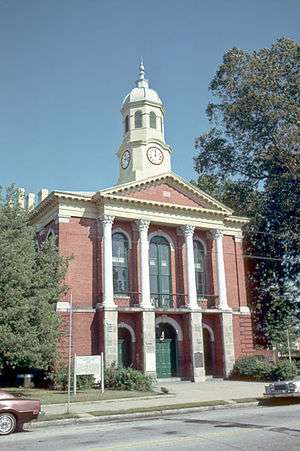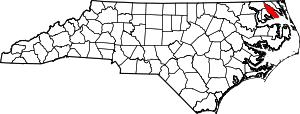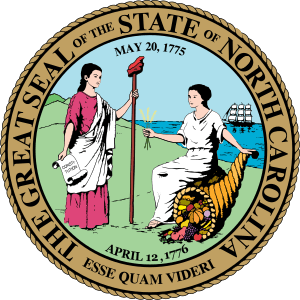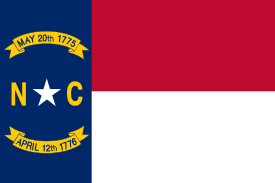Pasquotank County, North Carolina
Pasquotank County /ˈpæskwətæŋk/ (![]()
Pasquotank County | |
|---|---|
 Pasquotank County Courthouse | |
 Location within the U.S. state of North Carolina | |
 North Carolina's location within the U.S. | |
| Coordinates: 36°16′N 76°16′W | |
| Country | |
| State | |
| Founded | 1739 |
| Named for | Pasquotank River |
| Seat | Elizabeth City |
| Largest city | Elizabeth City |
| Area | |
| • Total | 289 sq mi (750 km2) |
| • Land | 227 sq mi (590 km2) |
| • Water | 63 sq mi (160 km2) 22%% |
| Population | |
| • Estimate (2018) | 39,639 |
| • Density | 179/sq mi (69/km2) |
| Time zone | UTC−5 (Eastern) |
| • Summer (DST) | UTC−4 (EDT) |
| Congressional district | 3rd |
| Website | www |
Pasquotank County is part of the Elizabeth City, NC Micropolitan Statistical Area, which is also included in the Virginia Beach-Norfolk, VA-NC Combined Statistical Area.
Geography
According to the U.S. Census Bureau, the county has a total area of 289 square miles (750 km2), of which 227 square miles (590 km2) is land and 63 square miles (160 km2) (22%) is water.[5] It is the fifth-smallest county in North Carolina by land area.
Almost all of the terrain in Pasquotank County is flatland with a topography near sea level, a characteristic of most of North Carolina's Coastal Plain. The county is flanked by two rivers: the Pasquotank—with which it shares its name—to the east, and the Little River to the west.
Adjacent counties
- Camden County (east)
- Perquimans County (southwest)
- Gates County (northwest)
National protected area
Major highways
Demographics
| Historical population | |||
|---|---|---|---|
| Census | Pop. | %± | |
| 1790 | 5,477 | — | |
| 1800 | 5,379 | −1.8% | |
| 1810 | 7,674 | 42.7% | |
| 1820 | 8,008 | 4.4% | |
| 1830 | 8,641 | 7.9% | |
| 1840 | 8,514 | −1.5% | |
| 1850 | 8,950 | 5.1% | |
| 1860 | 8,940 | −0.1% | |
| 1870 | 8,131 | −9.0% | |
| 1880 | 10,369 | 27.5% | |
| 1890 | 10,748 | 3.7% | |
| 1900 | 13,660 | 27.1% | |
| 1910 | 16,693 | 22.2% | |
| 1920 | 17,670 | 5.9% | |
| 1930 | 19,143 | 8.3% | |
| 1940 | 20,568 | 7.4% | |
| 1950 | 24,347 | 18.4% | |
| 1960 | 25,630 | 5.3% | |
| 1970 | 26,824 | 4.7% | |
| 1980 | 28,462 | 6.1% | |
| 1990 | 31,298 | 10.0% | |
| 2000 | 34,895 | 11.5% | |
| 2010 | 40,661 | 16.5% | |
| Est. 2018 | 39,639 | [6] | −2.5% |
| U.S. Decennial Census[7] 1790-1960[8] 1900-1990[9] 1990-2000[10] 2010-2013[2] | |||
As of the census of 2010,[11] there were 40,661 people, 13,907 households, and 9,687 families residing in the county. The population density was 154 people per square mile (59/km2). There were 14,289 housing units at an average density of 63 per square mile (24/km2). The racial makeup of the county was 56.7% White, 37.8% Black or African American, 0.3% Native American, 1.1% Asian, 0.0% Pacific Islander, 1.8% from other races, and 2.2% from two or more races. 4.0% of the population were Hispanic or Latino of any race.
There were 12,907 households out of which 33.4% had children under the age of 18 living with them, 50.4% were married couples living together, 16.3% had a female householder with no husband present, and 29.5% were non-families. 25.4% of all households were made up of individuals and 11.4% had someone living alone who was 65 years of age or older. The average household size was 2.52 and the average family size was 3.01.
In the county, the population was spread out with 24.9% under the age of 18, 11.3% from 18 to 24, 28.4% from 25 to 44, 21.3% from 45 to 64, and 14.1% who were 65 years of age or older. The median age was 36 years. For every 100 females there were 93.8 males. For every 100 females age 18 and over, there were 90.1 males.
The median income for a household in the county was $30,444, and the median income for a family was $36,402. Males had a median income of $30,072 versus $21,652 for females. The per capita income for the county was $14,815. 18.4% of the population and 15.5% of families were below the poverty line. Out of the total people living in poverty, 25.5% are under the age of 18 and 17.9% are 65 or older.
Law and government
Pasquotank County is a member of the Albemarle Commission regional council of governments.
| Year | Republican | Democratic | Third parties |
|---|---|---|---|
| 2016 | 47.0% 8,180 | 49.5% 8,615 | 3.4% 596 |
| 2012 | 42.2% 7,633 | 56.8% 10,282 | 1.1% 192 |
| 2008 | 42.8% 7,778 | 56.5% 10,272 | 0.7% 130 |
| 2004 | 48.4% 6,609 | 51.2% 6,984 | 0.4% 55 |
| 2000 | 45.3% 4,943 | 53.9% 5,874 | 0.8% 86 |
| 1996 | 38.3% 2,999 | 54.1% 4,233 | 7.5% 590 |
| 1992 | 35.7% 3,419 | 49.2% 4,709 | 15.2% 1,453 |
| 1988 | 50.8% 4,006 | 48.9% 3,860 | 0.3% 26 |
| 1984 | 54.6% 4,646 | 45.3% 3,854 | 0.2% 13 |
| 1980 | 43.4% 3,340 | 53.6% 4,128 | 3.0% 230 |
| 1976 | 37.9% 2,651 | 61.5% 4,302 | 0.6% 43 |
| 1972 | 63.1% 3,906 | 34.2% 2,115 | 2.8% 172 |
| 1968 | 18.8% 1,430 | 33.8% 2,564 | 47.4% 3,597 |
| 1964 | 35.8% 2,380 | 64.2% 4,269 | |
| 1960 | 28.7% 1,827 | 71.3% 4,530 | |
| 1956 | 38.1% 1,827 | 61.9% 2,963 | |
| 1952 | 37.0% 2,101 | 63.0% 3,579 | |
| 1948 | 24.0% 701 | 67.8% 1,976 | 8.2% 239 |
| 1944 | 25.3% 860 | 74.7% 2,540 | |
| 1940 | 13.3% 506 | 86.8% 3,314 | |
| 1936 | 9.1% 324 | 90.9% 3,226 | |
| 1932 | 10.0% 328 | 89.5% 2,946 | 0.6% 18 |
| 1928 | 29.5% 814 | 70.5% 1,943 | |
| 1924 | 19.6% 305 | 79.6% 1,236 | 0.8% 12 |
| 1920 | 22.6% 507 | 77.4% 1,736 | |
| 1916 | 18.7% 270 | 81.3% 1,177 | 0.1% 1 |
| 1912 | 6.2% 77 | 78.8% 972 | 14.9% 184 |
Education
- College of the Albemarle
- Elizabeth City State University
- Mid-Atlantic Christian University
Communities
City
- Elizabeth City (county seat)
Unincorporated communities
References
- Talk Like A Tarheel Archived 2013-06-22 at the Wayback Machine, from the North Carolina Collection's website at the University of North Carolina at Chapel Hill. Retrieved 2012-09-18.
- "State & County QuickFacts". United States Census Bureau. Archived from the original on June 7, 2011. Retrieved October 29, 2013.
- "Find a County". National Association of Counties. Retrieved 2011-06-07.
- "North Carolina: Individual County Chronologies". North Carolina Atlas of Historical County Boundaries. The Newberry Library. 2009. Retrieved January 25, 2015.
- "2010 Census Gazetteer Files". United States Census Bureau. August 22, 2012. Archived from the original on January 12, 2015. Retrieved January 18, 2015.
- "Population and Housing Unit Estimates". Retrieved July 24, 2019.
- "U.S. Decennial Census". United States Census Bureau. Retrieved January 18, 2015.
- "Historical Census Browser". University of Virginia Library. Retrieved January 18, 2015.
- Forstall, Richard L., ed. (March 27, 1995). "Population of Counties by Decennial Census: 1900 to 1990". United States Census Bureau. Retrieved January 18, 2015.
- "Census 2000 PHC-T-4. Ranking Tables for Counties: 1990 and 2000" (PDF). United States Census Bureau. April 2, 2001. Retrieved January 18, 2015.
- "U.S. Census website". United States Census Bureau. Retrieved 2008-01-31.
- Leip, David. "Dave Leip's Atlas of U.S. Presidential Elections". uselectionatlas.org. Retrieved 2018-03-17.

